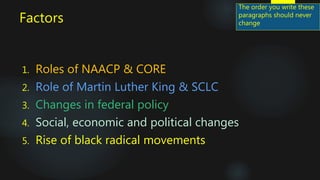The Civil Rights Movement met some needs of black Americans by ending segregation and securing key legislation, but ultimately failed to achieve full social, economic, and political equality. While groups like the NAACP and CORE successfully challenged segregation laws, and leaders like Martin Luther King Jr. gained important victories, discrimination and inequality persisted. Federal policies provided some support but did little to change racist attitudes. Social and economic conditions remained unequal, as evidenced by northern riots and the Kerner Commission report. As a result, more radical black movements emerged calling for alternative approaches to address the ongoing needs and grievances of black communities.






























